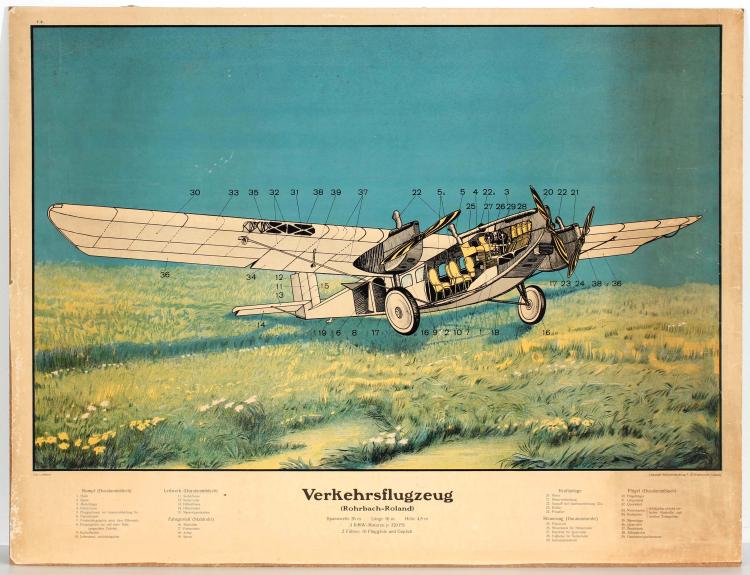
Fine Luft Hansa Ro VIII Roland cutaway in a pasture.
Tag Archives: Cutaway
TsAGI A-7-3a: Pollinator & Spotter.

The continuation of previous autogyro work at TsAGI (Central Aerohydrodynamic Institute), the development of the A-7 started in 1931. It was conceived by the later to become famous Nikolai Kamov to be employed in Army spotting, recon and liaison roles. First flown in 1934 the prototype, powered by a M-22 engine, was a substantial machine with a Cierva C.19 configuration. A prolonged development followed, with some propaganda intermingled. Of the latter my favourite was the agricultural demonstrations. Just a handful (seven, it seems) were built in three models. During the Winter War with Finland they saw service mainly as artillery spotters. They did the same briefly during WW2.
Prettier the cutaway than the subject.
Messerschmitt Me 309: Pretty on paper.

Faultless cutaway of the flawed Me 309.
Convair “Outpost”: Daddy Cool (LI).

Krafft Ehricke was one of those German rocket specialists recruited by the Americans after the end of WW2. By 1958, while working at General Dynamics’ Convair Division, he designed a four-man space station known as “Outpost” using the company Atlas ICBM as the basic structure of his station. Not seen here are the pair of superb two-seat wedge-shaped lifting body spaceships used as “lifeboats”. The space station went nowhere, but the “lifeboat” reappeared later in Ehrincke’s 1961 moonlander project. No buyers for that either.
With a gorgeous cutaway model and dressed to impress.
LACAB GR.8 Doryphore: Année 1936!!

Built at LACAB (Les Atelier de Constructions Aéronautiques Belges), the GR.8 Doryphore was designed in the mid-1930s to serve as a multi-role combat aircraft, quite similar to the French concept of that era. Not a good idea in hindsight, made it worse because it was a twin-engined biplane in 1936, the year of its maiden flight. Questionable in bombing and reconnaissance missions, it was also envisaged to be used even as an escort fighter(!!). Clear minds prevailed and only one prototype was completed. It was almost bought by the desperate Spanish Republicans but the embargo interfered. In the end it served with the Belgian AF until 1938 when it was damaged in a landing accident. It was repaired but remained grounded. The Germans found the Doryphore during the Belgium invasion, and soon scrapped it.
Pretty and informative cutaway of a clumsy aircraft.
Savoia-Marchetti S.66: Trimotore Civile.

Certainly pleased with their S.55, Savoia-Marchetti decided to keep the twin-hull catamaran configuration for the design of a bigger flying boat airliner. To power it the pylon-mounted tandem engines of the S.55 was replaced in the S.66 by three 750hp Fiat A.24R pusher engines mounted in three pylons. First flown in 1931, the two dozens produced served mainly with Ala Littoria. The survivors saw service in WW2 as SAR aircraft.
Lovely contemporary cutaway of the S.66’s right “scafo”.
EE Lightning F.1A: Just Because (CVII).

The complexity and density of an early Lightning “Starship” in this spellbinding cutaway of Arthur Bowbeer, “Flight” magazine (July 13, 1961).
CMASA CS.15: Vitesse Oblige.

This racy beauty was Italian entry into the land speed record rampage started by the Germans with the Bf 209/He 100D “battle”. Initiated by Fiat’s president Giovanni Agnelli, the project was assigned by the authorities to Fiat’s subsidiary Costruzioni Meccaniche Aeronautiche SA. Manlio Stiavelli (C-orsa S-tiavelli) was the designer of this slender all-metal stiletto powered by an engine which showed so much promise. The work of Antonio Fessia and Carlo Bona, the AS.8 was a +2.250hp 34.5-litre V16 marvel evolved with lessons learned from Tranquillo Zerbi’s peerless AS.6 which employed the latter slick but marginal wing surface condensation cooling system. Wind tunnel models promised 850 km/h. The project was started with some vigour in the spring of 1939, to be all but forgotten a year later when Mussolini dragged Italy into WW2. The unfinished prototype, after some damages due to Allied air raids, was destroyed by the retreating Germans. Gladly, one example of the stunning AS.8 survives at Vigna di Valle.
Charming 3-views cutaway. In Rosso Corsa, of course.
Mikoyan MiG-21F-13: Old Warriors soldier on.

A poor Czech F-13 drastically vivisected to show its fairly complex intake ducting, Letnany (Czech Republic). It became much more complicated in later models.
Photo: Milan Cibulka.
“Rettungsboje”: Lobster Kraut-Pots.

The “Rettungsboje” were Luftwaffe rescue buoys anchored in the English Channel close to the French coast during the early years of WW2. They’re set out so that any aircrew under distress over the sea could get a temporary shelter. Inside there was the necessary survival gear to keep them alive until a rescue could be achieved.
Magnificently informative cutaway drawing. The disabled bomber looks a lot like a single-tailed “Bf 110“.
